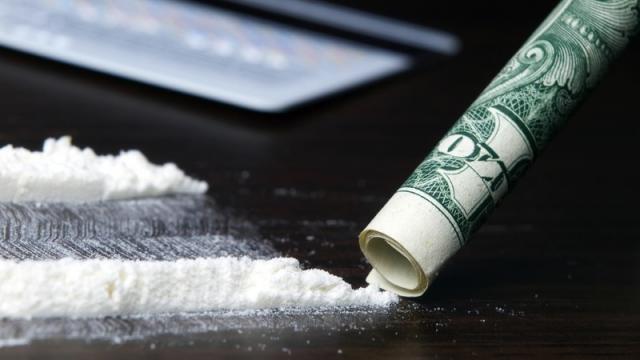Cocaine is a drug which has a certain ‘high life’ status attached to it, mainly because of its price. It is expensive. Conversely, amphetamines have a similar stimulant effect, yet their average street price is only a fraction of that of cocaine. The large profit margins make cutting cocaine with other substances a lucrative option for drug dealers. Most users are aware of the potential impurities of cocaine, but they do not know much about impurity levels or the modern adulterants used. To address this gap, we looked at a recent paper published by Julian Broséus and colleagues, from the University of Lausanne, where they describe what they found in cocaine [1].
The researchers analysed 6586 cocaine samples seized by police or customs officers in western Switzerland between 2006 and 2014. The samples were analysed with gas chromatography-mass spectrometry (GC-MS), a cutting edge method in forensic science to identify the chemical composition of substances.
All cocaine analysed was found in Switzerland, so the question that first presents itself is whether the results published are representative of the global market or not. While it is impossible to give a definitive answer, there are some reasons to think they are. As the authors point out, the data is consistent with similar reports from other institutions, although many of the other insitutions have a rather small sample size. Secondly, cocaine confiscated at the border is remarkably similar to samples collected at the street level. This suggests that most of the lacing takes place at a higher level, possibly even at the production site, before the drug reaches Switzerland. In summary, it is impossible to say whether these numbers are globally representative or not, but they are likely to be in the right neighbourhood.
Before diving into the data, an important distinction must be made. In the scientific literature, dilution refers to the cutting of cocaine with a pharmacologically inactive substance such as lactose, while adulteration refers to the adding of active material to cocaine, such as caffeine. Both dilution and adulteration contribute to the impurity of cocaine, but adulteration is potentially more troubling, due to the possibility of cross-interactions between active components.
Figure 1 shows a boxplot of the temporal evolution of cocaine purity (if you are unsure how to read boxplots, here is a quick video), that is the mass ratio of cocaine to all other substances in the samples. Throughout the 8 years the researchers examined, the purity remained stable at around 40%, meaning that less than half of the ‘cocaine’ bought is actually cocaine! Overall 97% of the samples have been adulterated, with an average of 3 adulterants added, while 88% of the coke specimens have been diluted, with an average of 2 diluent materials detected per sample.

Figure 1: boxplot of the time evolution of cocaine purity, see the main text for details.
Next, figures 2 and 3 show the frequency of diluents and adulterants encountered respectively. Note that unfortunately the paper only discusses the frequency of diluents/adulterants, but does not provide data regarding the mass of diluent/adulterants.

Figure 2: Frequency of adulterant found in cocaine samples.

Figure 3: Frequency of diluents found in cocaine samples.
The diluents are well known substances, mostly sugars, and by definition they are pharmacologically inactive. They are only mixed with cocaine to add bulk and hence to increase profits. These specific substances are likely to be used because of their wide availability and cheap price. When it comes to the adulterants the situation is more complicated, and a number of them could propose a health risk by themselves.
Phenacetin (or acetophenetidin) is a popular bulking agent, because it provides a numbing effect and has a similar physical look as cocaine. Historically it is an important medicine as it was the first non-opioid based analgesic (i.e. pain relieving medicine) without an anti-inflammatory effect. During metabolism phenacetin breaks down to paracetamol, which is a common ingredient in many fever medicines today. Phenacetin was introduced in 1887 by Bayer and it remained a popular medicine until 1983 when it was banned in the USA due to numerous side effects that include kidney failure and increased risk of certain cancer types. It is suspected that the famous 20th century entrepreneur, Howard Hughes, died from the side effects of the drug. Note that phenacetin was banned as a medicine, but to most countries it can be imported legally and it costs pennies.
Levamisole was first introduced to the medical market in 1966 and there have been clinical trials conducted for its ability to support the immune system during chemotherapy. However, in the US the Food and Drug Administration (FDA) has stopped the trials, because about 10% of the participants have developed agranulocytosis. Agranulocytosis is severe acute condition associated with the disappearance of white blood cells, a cell type that helps the body to fight infections, that could lead to severe and potentially lethal infections. In the meantime it has been discovered that it is an effective agent to treat parasitic worm infections and it is still used in agriculture to deworm livestock.
Levamisole is the new ‘big boy’ among cutting agents. It first appeared in the mid-2000s and its presence has been steadily rising since. Its sudden appearance and rise has been a bit of a mystery for multiple reasons. First of all it is more expensive and harder to acquire than traditional cutting agents like lactose. Second, cocaine appears to be laced with levamisole at the production sites in South America (we know this because levamisole also appears in samples obtained at production sites). This is unusual, because smugglers prefer to transport maximum purity products to minimise the volume of the shipments and then possibly add adulterants once the cocaine has reached the destination country.
There are multiple theories about levamisole’s rise, but the most likely explanation is its ability to pass the ‘bleach test’. On the street, the purity of coke is often tested by putting it into bleach: pure cocaine dissolves, while traditional adulterants either sink or color the bleach. However levamisole also dissolves in bleach, hence making it impossible to distinguish it from cocaine using this test. This might explain why high level dealers are lacing their product with levamisole: if it can pass the bleach test they might be able to sell their goods as pure at the wholesale level.
A second theory is that it may enhance the effects of cocaine. There is some evidence from rat experiments that while levamisole has a moderate activity on its own, it can potentiate cocaine’s reward and stimulating effect [2]. In all likelihood neither of these reasons explains in itself levamisole’s sudden rise, but rather their combination makes it an attractive adulterant.
The addition of levamisole to cocaine is a concern to many experts [3,4]. It is difficult to objectively estimate levamisole’s impact on the health of cocaine users, due to a number of confounding factors, like cocaine itself. Furthermore many doctors are not aware of levamisole’s potential effects and its use as a cocaine adulterant, hence the complications due to levamisole might be attributed to other factors.
As for the other, less frequent adulterants, lidocaine is the well known local anaesthetic, often used in surgery. It is a classic cocaine cutting agent, that is likely to be added for its numbing effect. Caffeine is the active ingredient of coffee that has a stimulant effect, therefore it synergizes with cocaine. Diltiazem is a medicine used in the treatment of high blood pressure and chest pain, it is not clear why it is used as an adulterant. Hydroxyzine is an antihistamine. It has an antagonistic effect on several neurotransmitter systems, hence it is a moderate antipsychotic. Tetracaine and procaine are both local anesthetics with a slight numbing effect similar to lidocaine.
So this is what the market looks like. As emphasized earlier, all samples analysed were confiscated in Switzerland between 2006-2014, but it is likely that there are no major differences in other markets, and there have been no notable shifts detected since 2014.
As we always try to emphasize in this blog, often the dose is the difference between harm and potential health benefit (as in the case of phenacetin). Levamisole can induce agranulocytosis if taken at certain doses, but it is a question whether that dose is in the same magnitude that coke users are exposed to. Unfortunately we could not estimate the expected exposure to phenacetin and levamisole for coke users, because the Swiss team only reported the frequency of the occurrence of adulterants, but not their mass. That being said, there have been cases of agranulocytosis reported in cocaine users, so unfortunately levamisole-induced health complications are likely to be relevant for coke users [3,4].
In our experience most cocaine users are surprised to find out that on average 40% of their cocaine is something else. That being said, the purpose of writing this piece is not to scare cocaine users, but rather to provide reliable, scientific data on dilution and adulteration, so users are better informed.
B Szigeti
References:
[1]: Broséus, Julian, et al. “Qualitative, quantitative and temporal study of cutting agents for cocaine and heroin over 9 years.” Forensic science international 257 (2015): 307-313.
[2]: Tallarida, Christopher S., Ronald J. Tallarida, and Scott M. Rawls. “Levamisole enhances the rewarding and locomotor-activating effects of cocaine in rats.” Drug and alcohol dependence 149 (2015): 145-150.
[3]: Chang, A., J. Oterloh, and J. Thomas. “Levamisole: a dangerous new cocaine adulterant.” Clinical Pharmacology & Therapeutics 88.3 (2010): 408-411.
[4]: Zhu, Nancy Y., Donald F. LeGatt, and A. Robert Turner. “Agranulocytosis after consumption of cocaine adulterated with levamisole.” Annals of Internal Medicine 150.4 (2009): 287-289.





